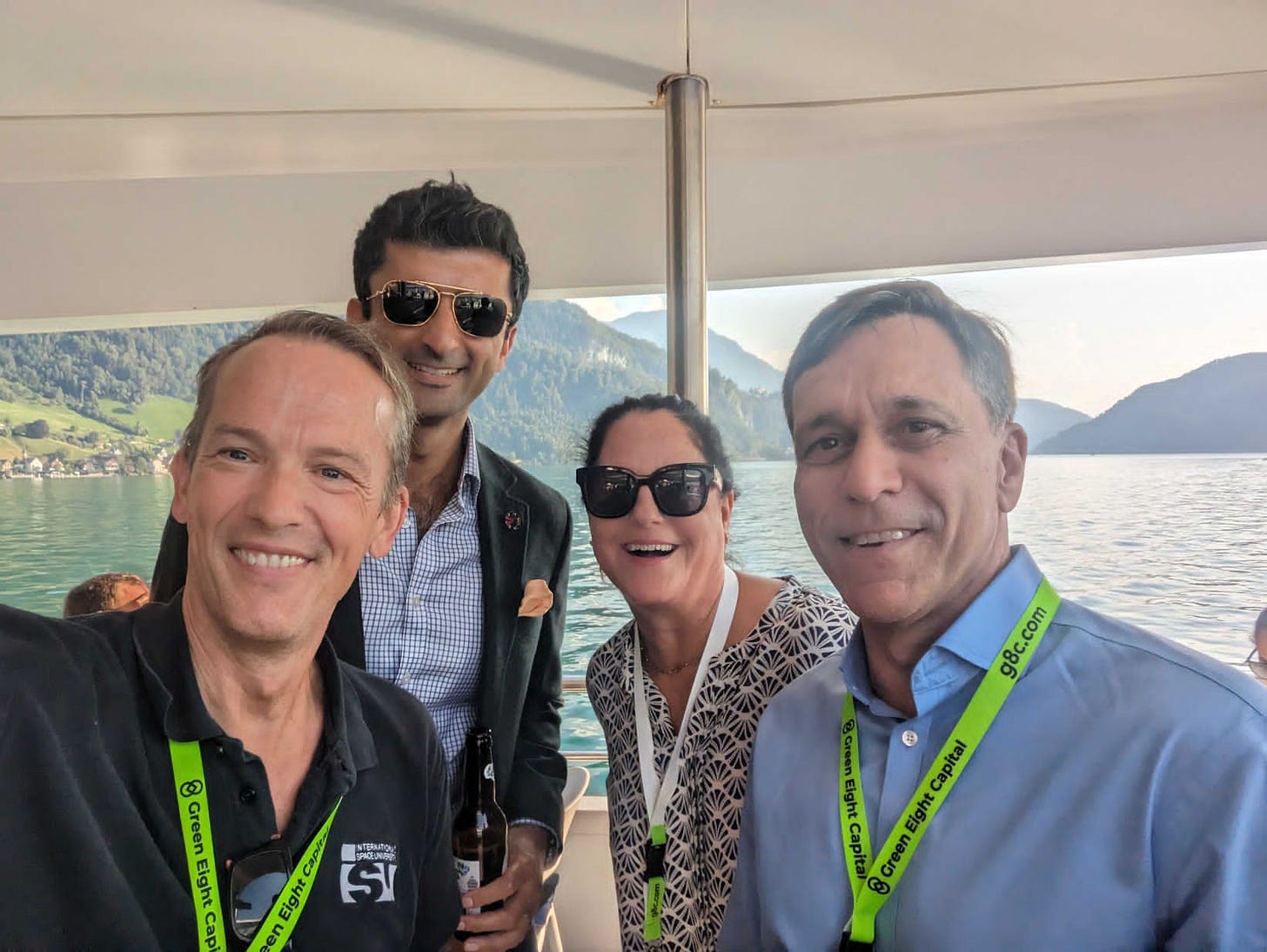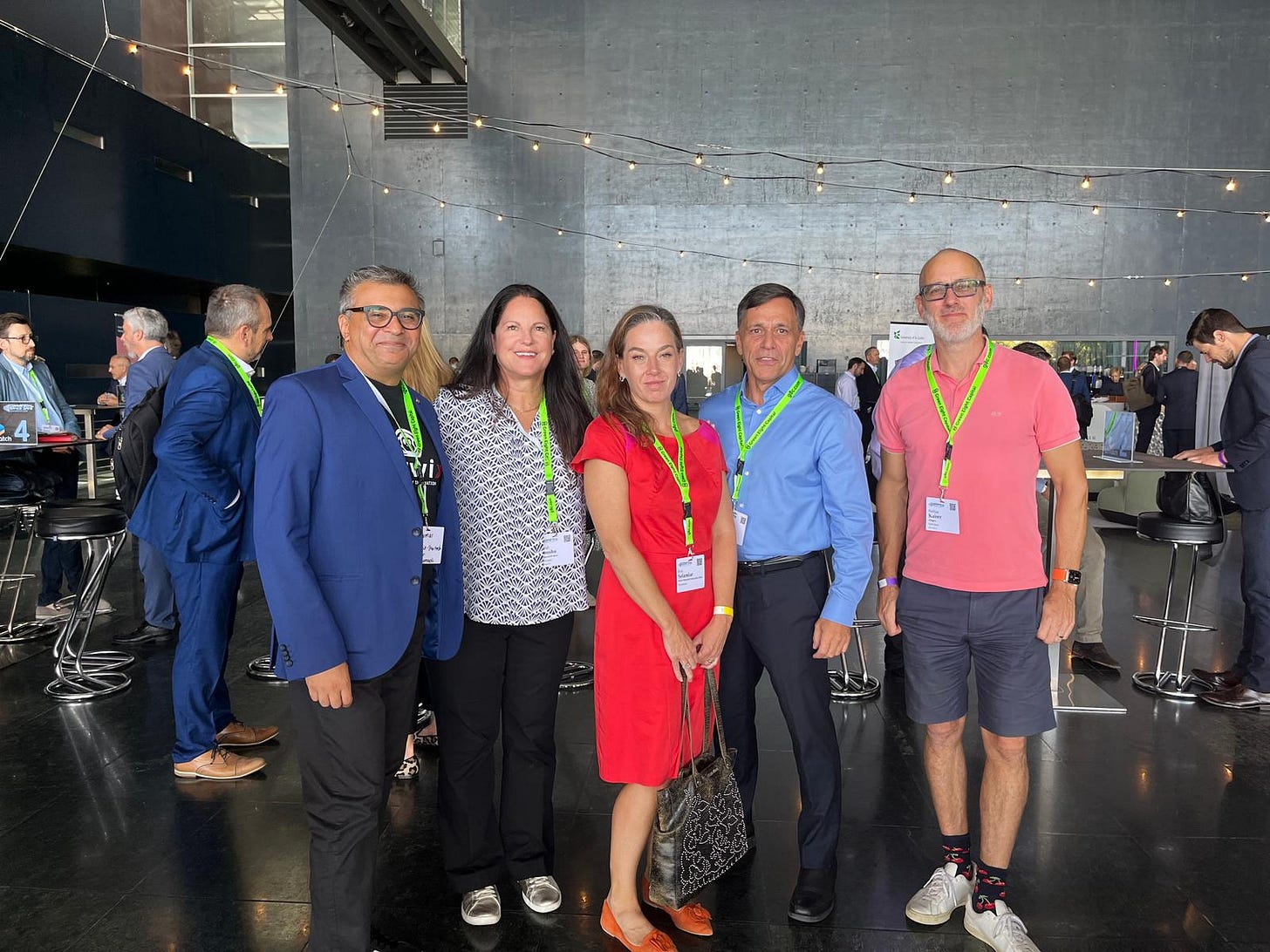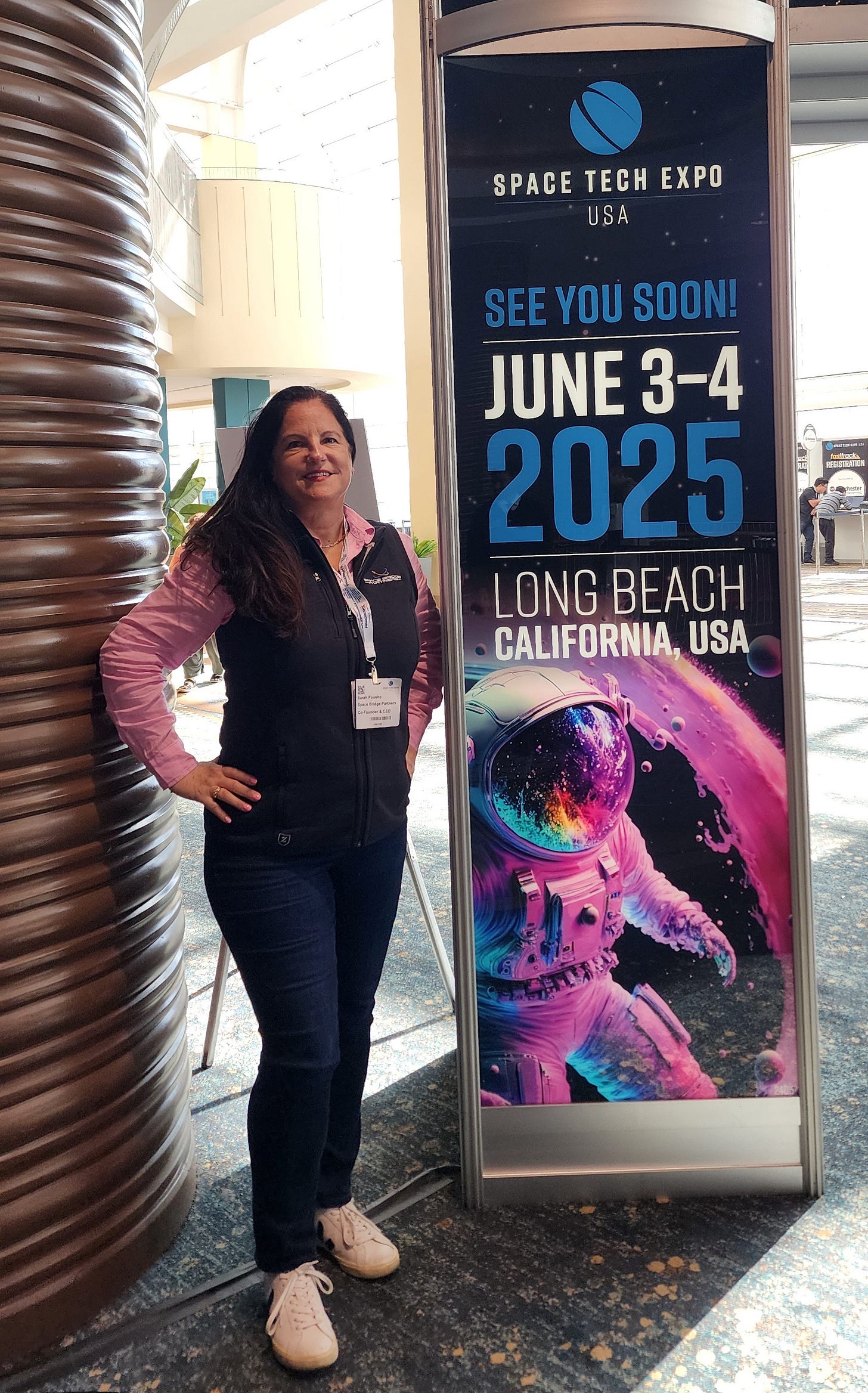Spotlight: Sarah Pousho - Co-founder and CEO @ Space Bridge Partners
Meet this remarkable woman who is bridging private capital with space missions dedicated to exploration, science, and education.
Issue: 133. Subscribers: 63,693.
Meet Sarah Pousho, Co-Founder and CEO of Space Bridge Partners-a pioneering consulting firm dedicated to connecting private capital with space missions focused on exploration, science, and education. With a 35-year track record spanning publishing, consumer products, and the space sector, Sarah has built global teams and secured strategic partnerships with industry giants like Disney, Warner Brothers, and Netflix. She’s recognized for launching and scaling product lines with top-tier retailers across North America, Europe, and Asia-Pacific, and for negotiating complex licensing agreements worldwide. Now at the helm of Space Bridge Partners, Sarah is bridging the funding gap for groundbreaking space missions, while championing the advancement of girls and women in STEM and the Space sector.
Space Bridge Partners connects our global network of private funding sources and space missions focused on exploration, science and education. Every year around the world, dozens of universities, civil space agencies, and nonprofit organizations plan crucial space missions focused on exploration, science, and education objectives, and then they struggle to get the funding needed to turn their dreams into reality. Ironically, at the same time there are hundreds of family offices, corporate brands and media producers that have funds available to support space projects. Unfortunately, they struggle to find the best way to connect with any space missions and structure a mutually beneficial relationship. Space Bridge Partners fills this gap in order to help humanity broaden its knowledge of the Earth and the universe in which we exist.
Sarah, most people think of space exploration as the domain of governments or billionaires. Why do you believe high-net-worth individuals and family offices should get involved now—and what kind of impact can they actually make?
Now is a pivotal moment in the space sector, especially in the U.S. where space and science budgets are being cut dramatically. All across the globe, the private sector is stepping up to support space startups and STEM fields in general. In addition, there are people all over the world who have become wealthy – and even wealthier – due to the current economic climate. Now more than ever before, people can make a significant impact in space and the future.
There are plenty of examples of this happening throughout history. Perhaps one of the most globally recognizable families whose wealth catalyzed the Renaissance was the Medici family. They used their vast wealth to fund art, science and culture. They funded Galileo, who invented the astronomical telescope, discovered Jupiter’s four moons and the phases of Venus, among many other things. A nonprofit called the Joint Himalayan Committee funded Sir Edmund Hilary’s first successful expedition to summit Mount Everest. In the late 20th century a philanthropist by the name of Sol Price funded scientist Leroy Hood's work which led to the development of an automated DNA sequencing machine, which eventually led to being able to map the human genome.
These names have – and will – go down in history as enabling technologies that have been significant for decades and even centuries. This is the kind of impact that can be made with the support of the impact or philanthropic arm of family offices, high net worth individuals, and their foundations. This kind of support in the space sector would help fund missions that will study Venus which can lead to helping us understand how we can combat climate change on Earth. It can also help further the studies about how space affects the human body and how we might survive living on another planet that does not have the same environmental conditions as on Earth. There are so many “firsts” yet to happen in space exploration that supporting these kinds of space missions could lead to historic family legacies being tied to game-changing missions.
What kinds of space research missions does Space Bridge Partners support, and how do you help sponsors see a return—not necessarily in capital, but in legacy, access, or influence?
Space Bridge Partners is specifically targeting space missions focused on exploration, science and education. These are missions that are usually put together by nonprofits, universities or small civil space agencies who often have difficulty raising funds for the full cost of the missions. These mission organizers have a diverse range of interests, all of which can benefit humanity and life on Earth.
By supporting these kinds of missions, funders would have many returns, including:
Having their name or brand tied to legacy-making missions
Knowing that their funds financed scientific research that could lead to tools and solutions that can be used by millions of people, such as GPS, memory foam, more effective medicines and thousands of other inventions that came from the space sector
Knowing that by funding these missions, they would be helping employ scientists across the globe
Their funding could also be supporting their alma maters at the same time
There’s a lot of buzz about space tourism—but Space Bridge Partners is focused on research. Why do you believe funding deep space research is more important—and more valuable—right now?
There is, indeed, a lot of buzz about space tourism right now, and I actually see that as a good thing. The mere fact that we can send six people who are not professional astronauts to space basically any time we want is incredible. Compare that to when NASA used up almost the entire U.S. national budget - $280B in today’s dollars – to send three people to the moon in the 1960’s. Today, we can send small satellites on a “ride-share” to space for a few hundred thousand dollars.
The declining costs of payloads make it much more economical to send scientific experiments to space. Humanity can do much more for less than in the past, and funders’ dollars can go much farther than ever before. By focusing money on scientific research, philanthropists can help accelerate breakthroughs that will help humanity live with less disease, more resources like clean water, and maybe even find a cure for cancer. These non-commercial missions will be vital first steps that will lead to incredible discoveries. And if you helped fund these missions with no direct financial ROI, you could also be on the front lines when the commercial opportunities present themselves and be able to take advantage at that time.
You’ve said that every sponsor supports a ‘new class of explorers.’ What does that really mean in practice—what kind of access, influence, or recognition do they receive?
Every sponsor that supports a mission focused on exploration, science and education can be proud of the fact that they have helped advance the knowledge gained from these kinds of research projects. Each mission has unique offerings or perks that will recognize the donors who supported them. Some mission organizers will be able to make their staff available to the donor for speaking engagements or workshops and similar opportunities. Other mission organizers might offer to put the donor’s name on their technology or the side of the rocket, or even have something in space named after the donor.
What are some of the most exciting missions Space Bridge Partners is helping fund right now—and what breakthroughs could they unlock for life on Earth?
Some of this was answered in previous questions, but without giving too much away, we have missions that will:
Figure out if/how humans can successfully reproduce in less than Earth’s gravity
Increase the success rate of in vitro fertilization by over 25%
Confirm sources of water on other planets and moons (which could be used to support living off-planet)
Discover biologic life that does not need water to survive
Be the first photographs of another planet’s atmosphere – from within its atmosphere!
Be one country’s first private mission to space and another planet
Be the fastest human-made object in space
These and many other missions will lead to advances in medicine, physiology, building materials, climate technology and so much more.
A lot of donors support education, health, or climate initiatives. How do you explain that space is not a luxury cause—but a core enabler of all those things?
Space has led to thousands of discoveries and inventions that are used by people on Earth every day, including GPS, memory foam, Nike Air sneakers, hook-and-loop fasteners, freeze-dried food, camera phones, ear thermometers, CAT scans, wireless headsets, smoke detectors, cordless vacuums and power tools, water purification systems and so much more!
We don’t even know what inventions lay ahead of us, but these scientific missions are vital to getting humanity to discover the next tool or tech that will change lives.
Philanthropists that are interested in science, technology, engineering and math (STEM) should see Space as a natural extension of their giving, since it encompasses all of the STEM verticals. Without STEM, missions would literally not be able to get off the ground.
Even if a STEM donor has a specific cause, such as women’s health, one can virtually guarantee there will be a mission that aligns with their cause.
Sarah, thank you for your interview. We wish you to succeed in your mission and support the breakthrough discoveries that will help humanity to make the leap forward!
At Space Ambition, we believe we are living in a new era of modern maecenas — visionary patrons of science and progress.
Since the 1990s, many individuals with deep scientific and engineering backgrounds have built successful careers in finance and technology. They understand, firsthand, how transformative innovation can be — and how it can shape a better future.
Through countless private conversations, we've come to see that many of them are quietly seeking meaningful ways to make an impact. They’re not just looking for returns — they’re looking for purpose.
If you count yourself among this tribe, or if you have bold ideas to share, we’d love to hear from you. Please reach out to Alexandra Vidyuk at alexandra@spaceambition.org.
We’d be happy to chat.
And remember — the sky is not the limit. It’s just the beginning.












✨ It’s inspiring that Space Bridge Partners is tackling a real challenge — bridging the gap between private capital and complex, science-driven space missions. A major reason this gap persists is the lack of clear structures for technology rights and the absence of transparent, robust tools for IP valuation and monetization.
💡 This is where LABRATE ROYALTY PRO can help — the world’s only analytical method for calculating royalty rates (RoS — Royalty on Sales) for know-how without relying on comparable market deals or paid IP transaction databases.
The method:
Accurately determines fair royalty rates for licensing technology,
Enables IP-backed financing (using patents or know-how as collateral),
Reduces legal risks and provides defendable valuations for damage claims or disputes.
🌍 LABRATE ROYALTY PRO is universal: it works across any jurisdiction and industry, making it ideal for cross-border deals, negotiations, litigation, and strategic tax planning.
🚀 In the space sector, this is especially relevant: smart IP licensing and collateralization can secure real funding for missions, while giving investors transparency and stronger protection.
📊 We continue LABRATE-based research in 19 countries under sectors 30.30 (NACE), 3364 (NAICS), and C3030 (ISIC), and we welcome new partners to expand the research geography and share insights together.